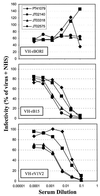Differential CD4/CCR5 utilization, gp120 conformation, and neutralization sensitivity between envelopes from a microglia-adapted human immunodeficiency virus type 1 and its parental isolate
- PMID: 11264346
- PMCID: PMC114848
- DOI: 10.1128/JVI.75.8.3568-3580.2001
Differential CD4/CCR5 utilization, gp120 conformation, and neutralization sensitivity between envelopes from a microglia-adapted human immunodeficiency virus type 1 and its parental isolate
Abstract
Human immunodeficiency virus type 1 (HIV-1) infects and induces syncytium formation in microglial cells from the central nervous system (CNS). A primary isolate (HIV-1(BORI)) was sequentially passaged in cultured microglia, and the isolate recovered (HIV-1(BORI-15)) showed high levels of fusion and replicated more efficiently in microglia (J. M. Strizki, A. V. Albright, H. Sheng, M. O'Connor, L. Perrin, and F. González-Scarano, J. Virol. 70:7654-7662, 1996). The parent and adapted viruses used CCR5 as coreceptor. Recombinant viruses demonstrated that the syncytium-inducing phenotype was associated with four amino acid differences in the V1/V2 region of the viral gp120 (J. T. C. Shieh, J. Martin, G. Baltuch, M. H. Malim, and F. González-Scarano, J. Virol. 74:693-701, 2000). We produced luciferase-reporter, env-pseudotyped viruses using plasmids containing env sequences from HIV-1(BORI), HIV-1(BORI-15), and the V1/V2 region of HIV-1(BORI-15) in the context of HIV-1(BORI) env (named rBORI, rB15, and rV1V2, respectively). The pseudotypes were used to infect cells expressing various amounts of CD4 and CCR5 on the surface. In contrast to the parent recombinant, the rB15 and rV1V2 pseudotypes retained their infectability in cells expressing low levels of CD4 independent of the levels of CCR5, and they infected cells expressing CD4 with a chimeric coreceptor containing the third extracellular loop of CCR2b in the context of CCR5 or a CCR5 Delta4 amino-terminal deletion mutant. The VH-rB15 and VH-rV1V2 recombinant viruses were more sensitive to neutralization by a panel of HIV-positive sera than was VH-rBORI. Interestingly, the CD4-induced 17b epitope on gp120 was more accessible in the rB15 and rV1V2 pseudotypes than in rBORI, even before CD4 binding, and concomitantly, the rB15 and rV1V2 pseudotypes were more sensitive to neutralization with the human 17b monoclonal antibody. Adaptation to growth in microglia--cells that have reduced expression of CD4 in comparison with other cell types--appears to be associated with changes in gp120 that modify its ability to utilize CD4 and CCR5. Changes in the availability of the 17b epitope indicate that these affect conformation. These results imply that the process of adaptation to certain tissue types such as the CNS directly affects the interaction of HIV-1 envelope glycoproteins with cell surface components and with humoral immune responses.
Figures







Similar articles
-
Determinants of syncytium formation in microglia by human immunodeficiency virus type 1: role of the V1/V2 domains.J Virol. 2000 Jan;74(2):693-701. doi: 10.1128/jvi.74.2.693-701.2000. J Virol. 2000. PMID: 10623731 Free PMC article.
-
Interaction with CD4 and antibodies to CD4-induced epitopes of the envelope gp120 from a microglial cell-adapted human immunodeficiency virus type 1 isolate.J Virol. 2005 Jun;79(11):6703-13. doi: 10.1128/JVI.79.11.6703-6713.2005. J Virol. 2005. PMID: 15890908 Free PMC article.
-
Ability of the V3 loop of simian immunodeficiency virus to serve as a target for antibody-mediated neutralization: correlation of neutralization sensitivity, growth in macrophages, and decreased dependence on CD4.J Virol. 2001 Apr;75(8):3903-15. doi: 10.1128/JVI.75.8.3903-3915.2001. J Virol. 2001. PMID: 11264379 Free PMC article.
-
HIV-1 envelope, integrins and co-receptor use in mucosal transmission of HIV.J Transl Med. 2011 Jan 27;9 Suppl 1(Suppl 1):S2. doi: 10.1186/1479-5876-9-S1-S2. J Transl Med. 2011. PMID: 21284901 Free PMC article. Review.
-
Synthetic peptides for study of human immunodeficiency virus infection.Appl Biochem Biotechnol. 2002 Jul-Dec;102-103(1-6):41-7. doi: 10.1385/abab:102-103:1-6:041. Appl Biochem Biotechnol. 2002. PMID: 12396109 Review.
Cited by
-
CD4-independent entry and replication of simian immunodeficiency virus in primary rhesus macaque astrocytes are regulated by the transmembrane protein.J Virol. 2005 Apr;79(8):4944-51. doi: 10.1128/JVI.79.8.4944-4951.2005. J Virol. 2005. PMID: 15795280 Free PMC article.
-
Macrophage-tropic HIV-1 variants from brain demonstrate alterations in the way gp120 engages both CD4 and CCR5.J Leukoc Biol. 2013 Jan;93(1):113-26. doi: 10.1189/jlb.0612308. Epub 2012 Oct 17. J Leukoc Biol. 2013. PMID: 23077246 Free PMC article.
-
Macrophage entry mediated by HIV Envs from brain and lymphoid tissues is determined by the capacity to use low CD4 levels and overall efficiency of fusion.Virology. 2007 Mar 30;360(1):105-19. doi: 10.1016/j.virol.2006.09.036. Epub 2006 Nov 7. Virology. 2007. PMID: 17084877 Free PMC article.
-
Variation in the biological properties of HIV-1 R5 envelopes: implications of envelope structure, transmission and pathogenesis.Future Virol. 2010 Jul;5(4):435-451. doi: 10.2217/fvl.10.34. Future Virol. 2010. PMID: 20930940 Free PMC article.
-
Identification of shared populations of human immunodeficiency virus type 1 infecting microglia and tissue macrophages outside the central nervous system.J Virol. 2001 Dec;75(23):11686-99. doi: 10.1128/JVI.75.23.11686-11699.2001. J Virol. 2001. PMID: 11689650 Free PMC article.
References
-
- Albright A V, Strizki J, Harouse J M, Lavi E, O'Connor M, González-Scarano F. HIV-1 infection of cultured human adult oligodendrocytes. Virology. 1996;217:211–219. - PubMed
-
- Alkhatib G, Ahuja S S, Light D, Mummidi S, Berger E A, Ahuja S K. CC chemokine receptor 5-mediated signaling and HIV-1 co-receptor activity share common structural determinants: critical residues in the third extracellular loop support HIV-1 fusion. J Biol Chem. 1997;272:19771–19776. - PubMed
-
- Alkhatib G, Combadiere C, Broder C C, Feng Y, Kennedy P E, Murphy P M, Berger E A. CC-CKR5: a RANTES, MIP-1α and MIP-1β receptor as a fusion cofactor for macrophage-tropic HIV-1. Science. 1996;272:1955–1958. - PubMed
-
- Atchison R E, Gosling J, Monteclaro F S, Franci C, Digilio L, Charo I F, Goldsmith M A. Multiple extracellular elements of CCR5 and HIV-1 entry: dissociation from response to chemokines. Science. 1996;274:1924–1926. - PubMed
Publication types
MeSH terms
Substances
Grants and funding
LinkOut - more resources
Full Text Sources
Research Materials

